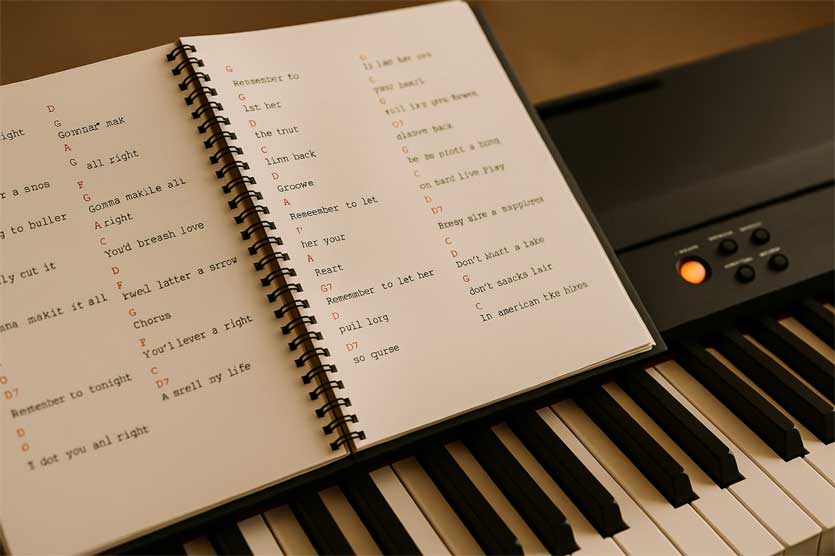If you want to be ready to sit down at a piano and play for anyone, anywhere, you need a repertoire — a set of songs you can play confidently, without fumbling for chords or lyrics.
Here’s a simple, practical way to put one together so you’re always ready for anything from a quiet singalong to a rowdy party.
Step 1: Gather Your Song List
Start by making a list of songs you’d like to play. Don’t worry yet about whether they’re easy or hard — just brainstorm. Once you’ve got your list, find the lyrics and chords for each song on a site like Ultimate Guitar.
Step 2: Create Your Song Sheets
Open a Word document and type out each song. Use the Courier font so chords line up neatly above the words, and put the chords in red so they stand out.
Print the whole batch on draft setting to save ink. These are your working copies. Play through and correct any wrong chords. If you’re stuck, look for official sheet music or a solid tutorial on YouTube.
Step 3: Match Keyboard Rhythms
For each song, try the rhythm/backing styles on your keyboard and note the one that works best so you don’t have to think about it live.
If the chords sit badly for your voice, transpose the keyboard up or down a few semitones and write down the exact transpose amount for that song.
Step 4: Make It Performance‑Ready
Have everything ready to go — sheets, keyboard settings, and order. Create three printed copies of the full folder so friends can follow the words or jam on guitar, etc.
Step 5: Refine the List
Keep weeding the list to songs you can make sound great. If you’re fine on the verses but the chorus falls apart, move that song to a work in progress folder. Your main repertoire should be songs you can deliver every time.
Step 6: Play to Your Audience
Think about who you’ll be playing for:
- Harmony lovers? Add The Carpenters and similar.
- Rowdy parties? Choose anthem songs with big, repeatable choruses. Hey Jude can go on as long as you like.
- Skip intricate solo showpieces at parties — people want to join in.
Blues piano is ideal: simple rhythms, three chords, easy for guests to sing along.

Step 7: Have a Safe Starter Song
If nerves hit, start with a guaranteed easy opener — something you can play in your sleep, that sounds cool without fancy fingering or a big melody. It settles you and wins the room.
Step 8: Cover All Ages
Include a mix so everyone gets a moment:
- Oldies: Beatles, Elton John
- Really oldies: “Knees Up Mother Brown”
- 30–40 crowd: from ABBA to Beyoncé
- 15–30 crowd: Adele, Sam Smith, current hits
Keep choices simple — songs with a few clear chords that are instantly recognisable.
Final Thought
A great repertoire isn’t about showing off — it’s about connection. Build the folder, keep refining it, and you’ll always be ready to make a room sing.
Need a beginner-friendly keyboard for these songs? Here’s how to choose one.



